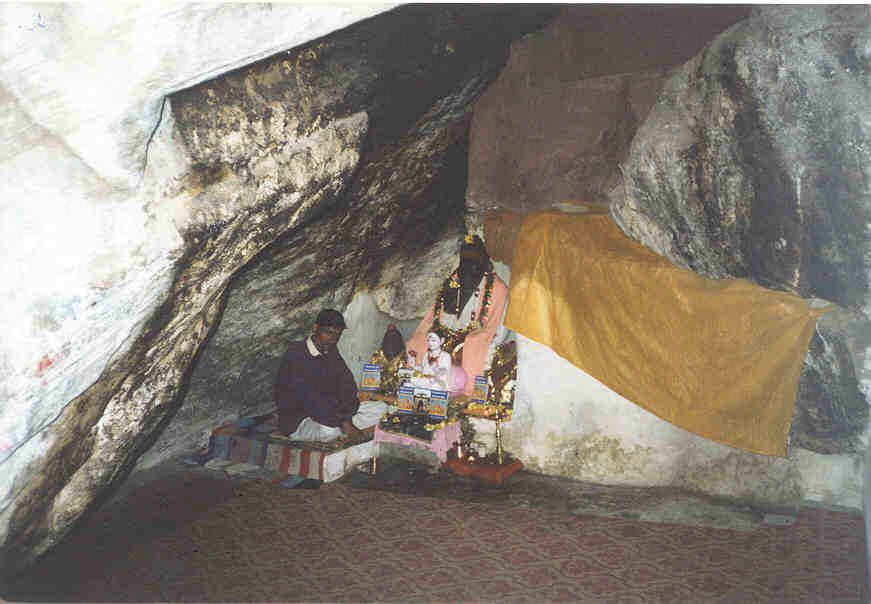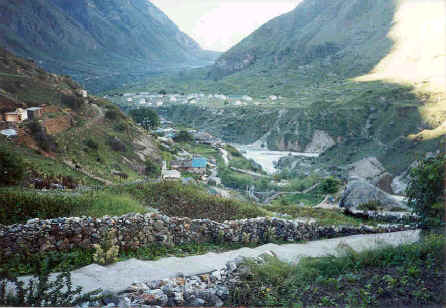Guest writer K. Ram Kumar continues his illustrated journey through
the Himalayas, visiting the ancient shrines at Badrinath, Kedarnath and more. See
also A Himalayan Journey - Part I. In this
part, Joshimath, Pandukeshwar
and Vyas Guh are covered. Part III will cover
Kedarnath.
Joshimath:
Joshimath, the first mutt established
by Shri Adi Sankara, is located at a distance of 14 kms from Helang
enroute to Badri. Adi Sankara is believed to have authored the work, Sri
Sankara Bhashyam here. This located at a height of 6150 ft above sea level. Here,
there are separate temples for Narasimha and Vasudev
(different forms of Vishnu). This is one of the 108 Divya Desams
(sung by Sacred Vaishnavaite Saints).
In the temple for Narasimha
, separate statues of Badri narayan, Uthavar, Kuber,
Chandikadevi, Ram, Lakshman, Sita and Garud can be seen together
in the sanctum sanctorum. Outside the temple separate statues of Brahma, Krishana,
Lakshmi & Anjaneya can be seen. Vyas Maharishi is believed
to have worshipped Goddess Lakshmi here. The presiding deity Narasimha
is believed to have been established by Adi Sankara. It is widely
believed that one hand of the presiding deity is getting weakened and the day it
disjoints, the way to Badri will get eternally blocked and that a darshan of Badri
Narayan would be possible only from Bhavishya Badri or Adi
Badri (part of Panch Badris).
The temple of Vasudev
houses Vasudev in the sanctum sanctorum as well
as Sridevi, Bhoodevi, Leela devi, Oorvasi devi & Balram in the outer
praharam. Further separate structures are available for Vinayaka, Brahma, Indira,
Chandran(Moon), Navadurgas & Gauri Shankar.
(Also see: Tiruppirudi (Joshi Math) and The Abodes of Vishnu)
Pandukeshwar
This place is believed to have been
established by King Pandu, father of Pandavas. It is situated at 4kms
from Govind Ghat, 219 kms from Kedarnath and 24 kms from
Badrinath. There are two temples – one for Lord Yogabadri
Narayan and the other for Vasudev. During winter,
Lord Vasudev temple will function as the abode for Badri
Narayan and all the daily rituals connected with worship are performed
here. Both the temples are quite old.
Vyas
Guh (The cave of the Sage Vyasa)

The village of Mana,
located at a distance of 3 kms from Badrinath is the last Indian Village situated in the
Indo-China Border and has gained historical importance on account of Vysas Caves.
This village, located on the
banks of River Saraswathi (only place where this river can be seen) is very beautiful. Vyas Maharishi (Sage), author of Mahabharata is
believed to have lived in the caves named after him. It is said that, Vyasa Maharish, upon being requested by his mentor
Kalpatru Maharishi in his dream, composed the Mahabharata, the eternal epic of
Hindus – depicting the history of Pandavas, Kauravs including Kurukshetra War and
most importantly Bhagawad Geeta (Chapter 18 of Mahabharata) – believed to have been
revealed by Krishna (reincarnation of Vishnu).
Ganesha, the
elder son of Shiva & Parvathi, is said to have helped Vyas Maharishi in composing this
epic in written form – the beginning of education in written form. In addition to Mahabharata,
Vyas Maharishi composed 18 puranas (legendary stories), Brahma
Sutras and classified the Hindu Vedas into 4 parts
– Rig, Yajur, Sama and Atharvana. Legend has it that Adi Sankara
met Vyas Maharishi in this cave, and discussed his Bhashyam (explanatory notes) for Brahma
Sutras.
The rock formation inside the
Vyas Guh appears to resemble the orderly stacking of palm leave
manuscripts – oldest writing material and is worshipped as "Vyas Pusthak".
Vyas Maharishi is also considered, by some, as reincarnation of Vishnu.
Another Cave called as Ganesh
Guh (cave) is also located in this village.

The village
also boasts of Keshav Prayag– Sangamam (confluence) of Rivers Saraswathi
and Alaknanda. Vasudhara Falls & Bhimpul Falls are nearby. Like
Badrinath, the village becomes inaccessible during winter (almost 6 months) and the entire
village vacates and moves to a safer place down the hills.
